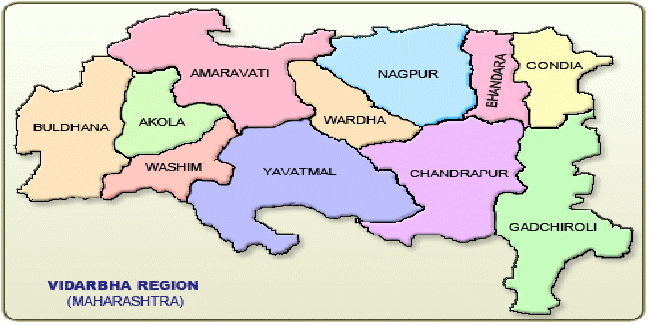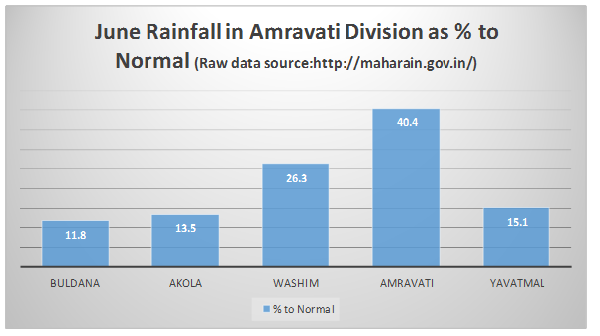
Perhaps it was the several disasters that came back-to-back, or the excitement in the build-up to New Year celebrations, but the 12 farmers in Vidarbha who committed suicide in the 72 hours leading to December 28, 2014, barely made news. Maharashtra has had the highest numbers of farmer suicides (as many as 60,750!) in the country between 1995 and 2013. On an average, 3,685 farmers in the state took their lives every year between 2004-13. This works out to over 10 farmer suicides per day for a decade!
While most of these suicides are from the Vidarbha region, they are now increasingly being reported from Marathwada too. Little wonder then that rural development observers like P Sainath call Vidarbha “the worst place in the nation to be a farmer.”
Why has what would've led to mass outrage anywhere else in the world, only led to ennui here? After the occasional TV debates, discussions, and newspaper analysis, this burning issue is only conspicuous by its absence from the intellectual space. Given that kind of apathy, is it at all surprising that even as the suicide statistics gallop away, there is no concrete solution to the problem in sight.
Multi-headed hydra
Many feel the single-pronged approach to the multifaceted agrarian crisis sweeping across Vidarbha and Marathwada is to blame. National agricultural policies, Minimum Support Price debacles, weak political leadership, lack of irrigation or inequitable distribution where its available, the humongous irrigation backlog, introduction of water and money-intensive GM cotton, ever increasing input costs of seeds, fertilisers and pesticides, diversion of irrigation water from farms to power plants and industries, bad crop insurance policies, hopeless revenue tools of calculating farm-losses in the event of droughts/excessive rainfall (paisewaari), arm twisting by middlemen, corrupt agro produce committees, poor household economic management by farmers, opportunistic money-lenders and even more opportunistic politicians work together to create quite a killer brew. While societal apathy to this issue only worsens the situation, the impacts of the conundrum of all this put together is only made starker by climate change, increasing pest attacks, decreasing micro-nutrients in the soil and misplaced relief packages.
Let's attempt joining dots in this picture, especially related to water and climate change. Eleven districts of the Nagpur and Amravati division in eastern Maharashtra's suicide country includes the tehsils of Yavatmal, Akola, Amravati, Wardha, Buldhana, Washim, Nagpur, Chandrapur, Bhandara, Gadchiroli and Gondia. This is 31.6% of the state's total area and home to 21.3% of its population. All the agricultural staples here - cotton, soybean, pigeon peas and chickpeas - are rain-fed. All the factors mentioned above come together in their worst permutation and combination here to ensure agro-productivity of the region is 15% lower than the remaining state and a whopping 46% lower than the national average!
In fact the ministry of agriculture has admitted on record that, the near 100% adoption of Bt cotton - highly sensitive to water-shortage - in a region marked by irregular rainfall and poor irrigation, is a high risk, high cost cultivation system. About 14 lakh hectares of the region is under cotton cultivation and nearly equal under soyabean. Many farmers had opted for the latter this year in the hope of better prices as cotton prices were dismally low. This was disastrous.

Rainfall in Vidarbha in 2014
Although the region does not show a very sharp dip in seasonal rainfall, its timing has always been crucial for agriculture. This also highlights district-wise limitations of or tehsil-wise seasonal rainfall. Almost all of the three-month soyabean crop in Vidarbha is rain-fed. The first blow was the June 2014 rains which were 80-85% lesser than normal in the region, leading to a major crop failure. This also sharply increased input costs (of seeds and labour) as it meant sowing twice and even thrice. After June, the rainfall erratically increased at places causing losses for cotton farmers. Later in the most crucial frond and fruit bearing stage for soyabean, it again disappeared. This meant loss of yield to the extent of 80% at places. This important rainfall anomaly gets ironed out in the monthly rainfall data which the authorities go by.
Absence of rain during this phase also hit the Bt cotton crop hard. This cotton species has shallower rooting zone, needs consistent water supply and cannot withstand water shortage. Rain failure in June meant an increased sowing cycle in July and buying the expensive Bt seeds from the market. This, like soyabean, sharply spiked input costs. In fact, most experts admit that Bt cotton has contributed significantly in pushing cost of fertilisers, pesticides and seeds through the roof. Yet, Bt cotton yield has been poorest in Maharashtra.
Adv. Balaji Yeavwar from Yavatmal told SANDRP, “After the first rains, rainfall disappeared for 15 days, then there was one very heavy bout and then again nothing for nearly a month, which was again followed by a heavy bout. And that was all. There was nearly no retreating monsoon showers which are so crucial for the rabi crop. The heavy intense rains didn't help crops, nor did the long dry spells.” This is underlined from the state government data which shows Nagpur district received less than 30% rainfall in June, more than 100 % in July (in two heavy bouts) and then again less than 50% in August! (maharain.gov.in). To make matters worse, rain gods continued to play spoilsport all through November (heavy bouts) and December (over 100% in Buldhana and a whopping 521% in Akola!) with unseasonal rain.
Erratic rainfall meant that crops were affected by pests and disease. Yield of both cotton and soybean fell sharply and cotton quality is poor. Cotton yield is down to 2-3 quintals/acre from over seven quintals/acre and that of soybean is about 1-2 quintals/acre down from about 5 quintals/acre.

Minimum Support Price (MSP) debacle
While input costs of labor, cotton seeds, fertilizers, weedicides and pesticides is rising, cotton MSP has increased to Rs 4,050/quintal a raise of only Rs 50/quintal. It is of course the worst kept secret that at the grassroots, actual procurement rarely happens at the official MSP cited. The government procurement centers look for cotton which they operationally define to suit themselves as “good quality,” a quality rare to come by in a year like this. So in reality, procurement prices are only nearing Rs 3,500.
In the case of soyabean, the official MSP is exactly same as last year's – Rs 2,560 /quintal! In this case the actual procurement price was about Rs 4,500 last year but has fallen by Rs 1,500 this year, a fall too huge for farmers. Sharply declined yields of both crops means they are caught between the devil and deep sea.
Now for argument sake just imagine this was happening in the case of sugarcane. Would the politically powerful sugar lobby and its its neta-babu coteries ever let sugar factories face this situation? Cutting across political lines the sugar mafia would have brought the government to its knees leading to an immediate bail-out like we saw in 2014, immediate funds for sick industry, a sustained media glare and all that. There is no such light at the end of the tunnel in the case of cotton/soyabean.
The BJP (now in power in both the State and Centre) election manifesto had clearly said: “We'll enhance profitability in agriculture, by ensuring a minimum of 50% profits over cost of production.” Forget profit over costs, the party – whose Chief Minister Devendra Fadnavis hails from the Vidarbha region – hasn't even been able to increase existing MSP... not even the bare minimum to keep them from hanging themselves to death in their own fields.
Water and Vidarbha
Like the rest of Maharashtra, irrigation is a clincher for agriculture in Vidarbha. Were existing irrigation projects handy in crisis? No, says Dr Nilesh Heda from Washim who has recently initiated a farm-produce company. Larger projects hardly reached far-flung farms, he points out and says, “The ones helped were malguzari tanks, small dams and village watershed projects which conserved soil moisture. But these are too far and few to have made any significant difference. Multicrore projects like Arunavati, Bembla and Adan which the state had promised would tackle the water problem have hardly made a difference to irrigation in the region even in crisis-mode.
Yet look at what is happening around the region. More such money intensive projects which will not slake the region's thirst are being planned. Already the project-affected from Jigaon Major Irrigation Project on Purna River in Buldhana district have called an indefinite fast and protest in the river at the dam site. Though more than 30,000 people of 47 villages will be directly affected by this project, not a single village has been rehabilitated as yet. Jigaon is among the many unnecessary dams planned in the state. The fact that tenders for the project worth Rs 1322 crores were floated against a budget of 60 crores indicates why such projects are planned in the first place.
Both projects - Jigaon in Buldana or Gosikhurd in Nagpur - are shrouded in cost and time delays. So much has already been said about how the Water Resources ministry became a milch cow under the erstwhile NCP-Congress government, it scarcely needs to be repeated. The way the Vidharbha arm of the state irrigation, Vidarbha Irrigation Development Corporation - stands out for its exuberant spending, poor quality work and lack of distributaries, requisite environmental and forest clearances, resettlement and rehabilitation of affected communities, points to the nexus between netas cutting across party lines. Of course this affects local communities but do they matter at all once elections are over?
Resilience of rain-fed farming
Meanwhile, 85% of the Vidarbha region is rain fed and will continue to remain so in the near future, despite all the big dams being planned, argues Jawandhiya. “There is an urgent need to address the problems of the present situation, without engaging in costly large dam and long distance distribution system dreams, which have failed throughout the state.”
He cites the International Crops Research Institute for the Semi-Arid-Tropics report to show how climate change is increasingly a reality in Vidarbha and Marathwada regions. The Intergovernmental Panel on Climate Change (IPCC) too has often underlined how extreme weather events are on a rise. In fact the IPCC has categorically warned that rainfall will become erratic, rainy days will reduce and intensity of rainfall increase. All this is already being experienced across Maharashtra, especially rain fed farming regions of Vidarbha and Marathwada.
Already the South Asia Network on Dams, Rivers and People showed after the March 2014 hailstorms in Maharashtra, the state does not even have a basic State Action Plan for climate change, despite having spent hundreds of crores on having ‘meetings' for nine years! The extent of the government's apathy in this regard got highlighted at the recently-concluded Climate Summit in Peru, where India once again failed to draw attention to climate change victims and demand compensation for losses. After all, 60,750 farmers who ended their lives in the past 13 years amount to nothing in front of the speeding development juggernaut, do they?
Not beyond recall...
The farming situation in Vidarbha and Marathwada is dismal. It calls for targeted efforts and solutions from all fronts. From agricultural policies to irrigation benefits, from more equitable water management to addressing climate change. The first step could be to increase MSP, making it commensurate with input costs and appropriate profits, as promised by the BJP before coming to power. This is a basic right of the farmer, who keeps getting mocked like a beggar with grandiose on-paper debt waivers by a gloating government.
The next steps could be a complete shift of focus from useless big dams to development of local watershed structures, farm ponds, market linkages and processing industries, targeted efforts to increase mitigation and adaptation capacities of farmers fighting climate change. Till that happens Vidarbha will continues to remain “the worst place for being a farmer.”